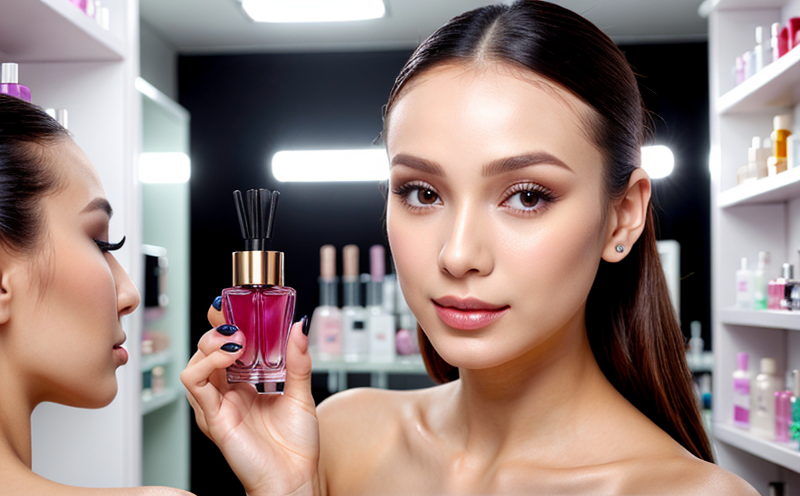Light Stability Testing of Perfumed Products
The light stability testing of perfumed products is a critical step in ensuring that cosmetic formulations maintain their sensory qualities, shelf life, and overall product integrity. This process involves exposing the fragrance or perfume to controlled light sources under specified conditions to assess how well it withstands photodegradation. Photodegradation can lead to color changes, loss of aroma intensity, and even chemical breakdown, all of which are undesirable in perfumed products.
The testing protocol typically follows international standards such as ISO 21097:2018 for light stability testing of cosmetic products. These protocols specify the types of light sources (e.g., xenon arc lamps), exposure times, and environmental conditions that should be used to mimic real-world storage scenarios. The goal is to simulate accelerated aging through controlled laboratory conditions, thereby predicting long-term product performance.
During testing, samples are exposed to varying intensities of light for predetermined durations. The extent of photodegradation can then be quantified by measuring changes in color parameters (such as CIELAB coordinates), aroma intensity via sensory evaluation or gas chromatography, and other relevant physical properties like viscosity and pH.
The results from this testing are crucial for several reasons:
- Quality Assurance: Ensures consistent product quality across batches by identifying potential issues early in the development or production process.
- Product Development: Helps formulate products that meet consumer expectations and industry standards, enhancing brand reputation.
- Regulatory Compliance: Satisfies regulatory requirements set forth by bodies like the FDA, EU Cosmetics Regulation, and others, ensuring compliance with stringent safety and efficacy criteria.
Why Choose This Test
The light stability testing of perfumed products is essential for several reasons. Firstly, it aids in maintaining the aesthetic appeal of perfumes by preventing color shifts and maintaining consistent aroma profiles over time. Secondly, this test helps in optimizing formulation ingredients to ensure they do not degrade under typical consumer storage conditions. Additionally, it supports regulatory compliance with international standards like ISO 21097:2018.
For quality managers and R&D engineers, light stability testing provides valuable insights into the performance of new fragrance formulations. It also allows for adjustments to be made during development stages, ensuring that products meet both internal and external expectations. Compliance officers benefit from this test by validating that their products adhere to all relevant regulations, thus minimizing legal risks.
The test is particularly beneficial in the context of cosmetic industry trends where consumers are increasingly demanding high-quality, long-lasting fragrances. By investing in light stability testing early on, manufacturers can enhance customer satisfaction and loyalty while differentiating themselves from competitors who may not prioritize such rigorous quality control measures.
Competitive Advantage and Market Impact
Investing in light stability testing of perfumed products offers significant competitive advantages that can drive market success. By ensuring that your perfumes retain their sensory qualities over extended periods, you not only enhance customer satisfaction but also build brand loyalty. This is especially important given the high demand for premium quality cosmetics among modern consumers.
Light stability testing also contributes to improved product longevity, which translates into reduced waste and lower production costs. For procurement teams, this means better supply chain management through more accurate forecasting of raw material needs based on tested data. Moreover, adhering to rigorous standards demonstrates a commitment to quality that can significantly boost brand image and trust among consumers.
In today’s competitive market, where sustainability and ethical practices are key factors influencing consumer purchasing decisions, light stability testing supports these values by reducing waste and promoting responsible manufacturing processes. This aligns with broader industry trends towards eco-friendly and sustainable practices.
Use Cases and Application Examples
The use cases for light stability testing in fragrance development are diverse, ranging from early-stage formulation optimization to final product validation before launch. During the initial stages of new fragrance creation, this test helps chemists identify potentially unstable components or combinations that could cause issues during prolonged storage.
For example, a team developing a new cologne might use light stability testing to determine which alcohol solvents work best with their chosen essential oils and synthetic compounds. By exposing samples to high-intensity lights over several weeks, they can observe how different formulations react and make informed decisions about ingredient selection.
In the later stages of development, this test ensures that the final product meets all necessary requirements for market release. For instance, a perfumer may use light stability testing to confirm that their newly developed eau de parfum will maintain its desired color and aroma profile throughout its shelf life when stored under typical consumer conditions.
Additionally, this test can be employed during production scaling up activities where consistency across large batches needs assurance. Light stability testing helps manufacturers monitor production processes to ensure that each batch produced meets the same high standards of quality.





